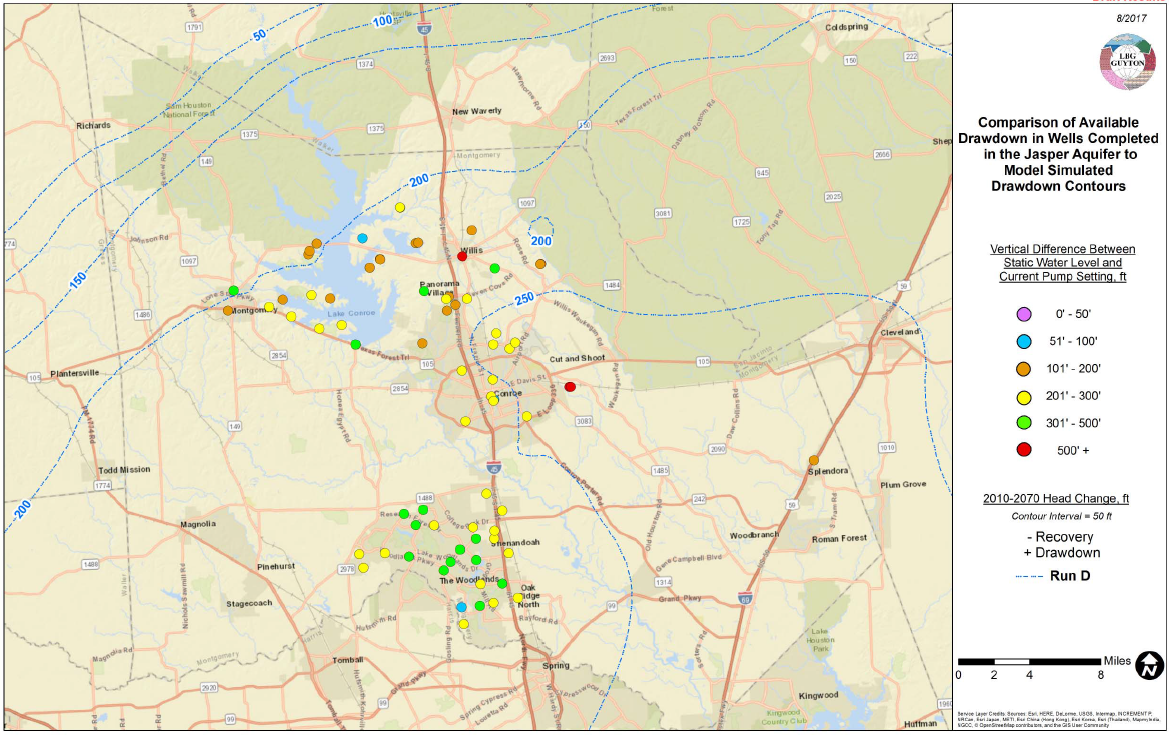By: Heather Ramsey Cook, Director of Communications and Public Affairs.
The problems associated with pumping too much water too quickly from the aquifers in our region are well-documented. For over 50 years, utilities in Harris and surrounding counties have been limiting their groundwater pumpage and supplementing their supplies with surface water from nearby lakes because over-reliance on groundwater has led to declining water levels.
This shift to reduce the use of groundwater and utilize alternate water supplies is due to the serious consequences that can result from over-pumping our region’s aquifers. Across the entire Houston region, including Montgomery County, over-reliance on groundwater has led to increased pumping costs, decreased well reliability, and in some cases water well failures. Declining groundwater levels also result in serious and costly sinking of the land surface due to
The problems associated with unchecked water-level declines in the Houston region have been studied since the mid-1900s. These problems are well-documented not just by the Texas Water Development Board and the U.S. Geological Survey, but also by the local engineering community. Unmanaged aquifers can lead to water supply problems such as reduced well yields and increased concerns over the ability of existing wells to keep up with demand. Wells that have been reliable for years can require expensive overhauls or have to be replaced with even more expensive new wells.
Hundreds of cities and water utilities in the greater Houston region have spent billions of dollars over the last 50 years to reduce their reliance on groundwater and develop alternate water supplies to meet their growing water demands. Montgomery County is only just now seeing the costs of increasing population and development that other utilities in our region experienced decades ago. Surrounding utilities and management districts had to find ways to supplement and preserve their groundwater supply. Turning to surface water supply, they adopted forward-looking policies and solutions to avoid saddling future generations with even bigger problems. Although water costs can go up as a result, they chose to make the investment when the easy political choice would be to kick the can down the road.
The City of Houston and other Harris County utilities made the bulk of the initial investment in alternative water supplies, followed by utilities in Fort Bend and Montgomery counties. Investment began in the 1970s with the construction of Lake Houston, Lake Conroe, and Lake Livingston along with billions of dollars in infrastructure improvements to treat and distribute water. More recently, the completion of the Luce Bayou interbasin transfer project, expands the City of Houston Northeast Water Purification Plant along with miles of large-diameter transmission lines and pump stations to distribute surface water across north Harris County. With an estimated investment of approximately $4.75 billion in State Water Implementation Fund for Texas (SWIFT) loans, these partners are planning for the future of Harris County.
Similarly, Montgomery County utilities, through a joint project with SJRA, entered into a project in 2010 to develop the Groundwater Reduction Plan and construct a water treatment plant at Lake Conroe. The project was built in response to regulations set by our local groundwater management district, the Lone Star Groundwater Conservation District (GCD), to ensure the reliability of groundwater supplies. Utilities throughout the county have worked for over 10 years to optimize groundwater resources while also planning for a source of water to accommodate Montgomery County’s growth.
Recently Lone Star GCD announced its intention to void all groundwater pumpage restrictions in Montgomery County. Modeling has shown that even a modest increase in pumpage in Montgomery County will cause significant water-level declines in north Harris and southern Montgomery counties. (See figure below).
Harris County’s groundwater regulations have been in place since the late 1970’s. Lone Star GCD’s groundwater regulations have been in place since 2006. Lone Star GCD’s actions threaten decades of sound research and economic investments made by utilities in the region to develop new water supplies for the future. These investments were made to prevent subsidence and flooding while ensuring adequate, reliable water supplies for the region’s rapidly-growing population and economy.
Lone Star GCD is asking for stakeholder input regarding their new proposed rules to void groundwater restrictions. If you would like to let the Lone Star GCD board know that you support a groundwater management plan that protects our region from further water-level declines, subsidence, and flooding—practices that have been in place for our aquifers for more than 40 years—contact them at (936) 494-3436, or at their office at 655 Conroe Park North Drive, Conroe, Texas 77303 or https://www.lonestargcd.org/ and go to the “Contact us” tab.
For additional information on the groundwater in Montgomery County or SJRA, please visit our website at www.sjra.net or follow our social media channels (Facebook @SanJacintoRiverAuthority and Twitter @SJRA_1937).

Subsidence is sinking of the land surface. When we pump large amounts of groundwater from the aquifers beneath the ground, we pull water out of the many layers of clay, which allows the clay to compact and the land to sink. Sinking of the ground makes it more susceptible to flooding.
Featured in June, 2019 Issue of Dock Line Magazine.

